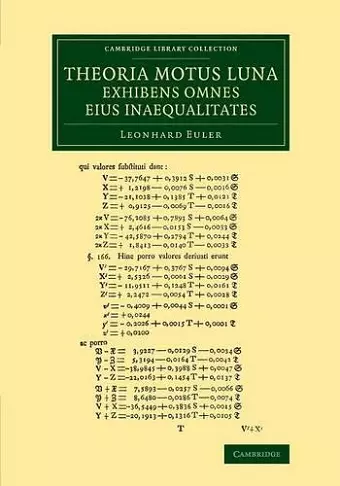Theoria motus lunae exhibens omnes eius inaequalitates
In additamento hoc idem argumentum aliter tractatur simulque ostenditur quemadmodum motus lunae cum omnibus inaequalitatibus innumeris aliis modis repraesentari atque ad calculum revocari possit
Format:Paperback
Publisher:Cambridge University Press
Published:2nd Jan '14
Currently unavailable, and unfortunately no date known when it will be back

Leonhard Euler's triumphant solution of the problems surrounding the moon's orbit, published in Latin in 1753.
The Swiss mathematician Leonhard Euler (1707–83) studied the problems surrounding the moon's orbit throughout his life. The present work, published in Latin in 1753, is his triumphant solution, showing that Newton's laws were sufficient to explain lunar motion.The problem of the moon's orbit was one that Leonhard Euler (1707–83) returned to repeatedly throughout his life. It provided a testing ground for Newton's theory of gravitation. Could the motion of the moon be entirely accounted for by Newton's theory? Or, as Euler initially suspected, did other forces need to be invoked? For practical purposes, if the moon's orbit could be accurately predicted, its motion would provide the universal timekeeper required to solve the longitude problem. In addition to the mathematical 'three-body problem', a topic still under investigation today, Euler was faced with the statistical problem of reconciling observations rendered inconsistent by experimental error. The present work, published in Latin in 1753, is Euler's triumphant solution. It may not be the last word on a subject which has occupied mathematicians and astronomers for over three centuries, but it showed that Newton's laws were sufficient to explain lunar motion.
ISBN: 9781108065351
Dimensions: 254mm x 178mm x 19mm
Weight: 630g
362 pages